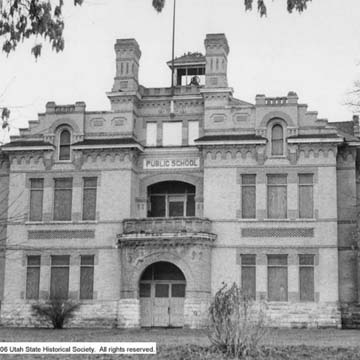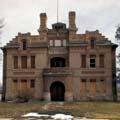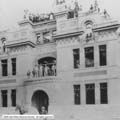You are here
Spring City Community Center
Special emphasis was placed on public education during the Progressive Era (1890–1920s), since progressives believed that education was key to the moral redemption of an industrialized society. Running parallel to this Progressive Movement, the Church of Jesus Christ of Latter-day Saints (the Mormon Church), the most powerful institution in Utah, supported education’s transition from the semiformal and familial context to formal public establishments. The state introduced Utah’s Free Public School Act in 1890. The Act required local school districts to make free public education available for all children from kindergarten through high school. Small, one-room schools were consolidated into distinctive multi-level school buildings that were erected throughout the state, including the Spring City School, which was designed by architect Richard C. Watkins in 1899.
In a town marked by vernacular architecture, the Spring City School stands out as its most impressive landmark, and indeed, it is one of Utah’s outstanding examples of public school architecture. The two-and-a-half-story brick building is rectangular in plan and features a hipped roof. Patterned brick around the doors, windows, and cornice creates surface richness and interest. The roof over the projecting round-arched entrance canopy forms a second-floor balcony with curved corners. At the roofline above the entrance canopy are two corbelled and patterned brick chimneys. Stepped gables at either end of the main facade and on the side facades provide additional visual interest. A small, central bell tower caps the hipped roof. Groups of three windows frame the entrance on the first two stories and are also located on the third level of the entrance bay. Round-arched windows in the stepped parapet break the eave line. On the interior, four ample classrooms are found on each level with public spaces (stairwells, water closets, and lobbies) at the center.
Perhaps the most distinguished designer of schools during the era, Watkins was well known for his work on many other public buildings in Central Utah. He immigrated with his parents to Utah from Bristol, England, in 1872. When Watkins moved to Salt Lake City in the 1880s, he already had experience in the building trades and secured a job at the office of Richard K. A. Kletting, Utah’s premier architect of the day and designer of Utah State Capitol. Watkins was the architect for more than ninety-five schools during his career, many in Sanpete County or other Central Utah towns. In 1911 he was appointed architect for state schools.
Spring City School was in use until 1959, and remained vacant until 1977, when the Daughters of Utah Pioneers purchased the building. It was designated part of the Spring City Historic District the following year. Since that time, Friends of Historic Spring City has completed necessary repairs and seismic upgrades. In 2017, the building reopened as the Spring City Community Center.
References
Writing Credits
If SAH Archipedia has been useful to you, please consider supporting it.
SAH Archipedia tells the story of the United States through its buildings, landscapes, and cities. This freely available resource empowers the public with authoritative knowledge that deepens their understanding and appreciation of the built environment. But the Society of Architectural Historians, which created SAH Archipedia with University of Virginia Press, needs your support to maintain the high-caliber research, writing, photography, cartography, editing, design, and programming that make SAH Archipedia a trusted online resource available to all who value the history of place, heritage tourism, and learning.



















